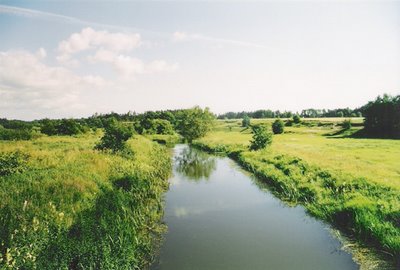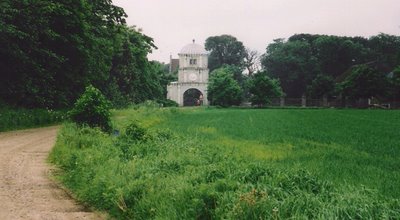
Framlev Church, 10 km west of Århus
The large Romanesque church in Framlev was built in the 1100s. The choir and the nave are travertine and raw granite. The eastern gable of the choir has three large round-arched blind archades and above in the roof gable is placed a limestone ashlar portraying the crucified Christ above an animal head. Two Romanesque windows are bricked-up, while four others are in use. The north door is bricked-up, while the south door has a tympanum with a lion figure. The tower with a pyramid roof and the porch are both in monk bricks and added in the late Middle Ages. Except for the tower the church is white-washed.

In the late Middle Ages the choir was equipped with an octagonal vault without wall curves. Two Romanesque frescoes are preserved - a decoration in the north window of the choir and a Maria-image from ab. 1250. An oak plank with a round-arched window-opening from an earlier wooden church is now at the National Museum. The communion table in monk bricks is covered in a Renaissance panel. The altar piece is from 1590 with an new painting and upon the communion table is a large medieval lectern in oak with carved Gothic ornaments, and upon the lectern a bible from 1633 , equipped with a new binding. The Romanesque granite font has double lions. A carved font sounding board from 1663 and an akvamanile from ab. 1350 are now at the National Museum. The pulpit with a sounding board is Renaissance from 1602 with an entrance panel from 1604 made by Morten Snedker and with original paintings, fx. the coat of arms of Arild Huitfeldt. A late Gothic parish clerk chair with the coat of arms of Niels Clausen Skade. Closed pews with triangle gables and with the year 1654. In the porch is walled two Romanesque gravestones with cross and other figures. Besides gravestones from the 1600s.

Chicken yard with both hens and cattle opposite the church.
Jes Bonde bought estate in Framlev, exchanged with Ribe Chapter and sold it before 1341 to hr. Ove Hase.
Rural dean Jens in Århus endowed 1313 among others a farm in Lillering for an altar in Århus Cathedral.
Estate in Labing was exchanged by hr. Stig Andersen Hvide 1336 to the chapter in Århus.
Labinggård was after having belonged to Palle Bryning and hr. Markvard Rostrup the object of an exchange and belonged in 1484 to Erik Ottesen Rosenkrantz; in 1514 it was owned by Tvilum Kloster, which had pawned it to bishop Niels Clausen Skade of Århus.
Labing mølle is mentioned in 1385; in 1587 it was endowed to Christen Munk of Gjessinggård, but it belonged in 1613 to Skanderborg Slot, later to Lyngbygård.
Hørslevgård was by Albert Skeel exchanged to the Crown in 1541.
Vorgård was sold by Erik Hvas (of Ormstrup) 1475; still in the 1600s there was only one farm. The esquire Thomas Jensen of Snåstrup is mentioned in 1460.
In the parish are two sacred wells, Hulken between Hørslevbol and Skovby, now an ordinary watering place, and Sct. Thomas kilde south of Framlev; the last is said having been used in the 1800s.
Højbygård is the rest of a village Højby (1398 Høyby), which is mentioned as desolate in 1683. In the parish is also mentioned a farm Kirkegård (1492 Kirchygarden); it had burnt down in 1683.
Listed prehistorics: A dolmen chamber without cover stone west in the parish and 3 hills, of which one at Labing is large.
Demolished or destroyed: two dolmens and 34 hills.
At Snåstrup have been found a burial site from Roman Iron Age with clay pots, bronze buckles, pearls etc.
Names in the Middle Ages: Framlev (1310 Framleff, 1341 Framløf); Labing (1336 Labum, 1480 Labing) ; Hørslev (1480 Hørsløff); Hørslevbol (1541 Bolen, Bolem, 1573 Hørsløffbuoll (e)); Lillering (1263 Lille Rings marck, 1313 Litlærind); Snåstrup (1398 Snalstrup, 1460 Snalstrvp); Vorgårde (1475 Wordgaardt); Labinggård (1418 Labinggaard); Hørslevgård (1480 Hørsløffgaard).
Source: Trap Danmark, Århus amt, 1963
photo 2004 Framlev:grethe bachmann
















































